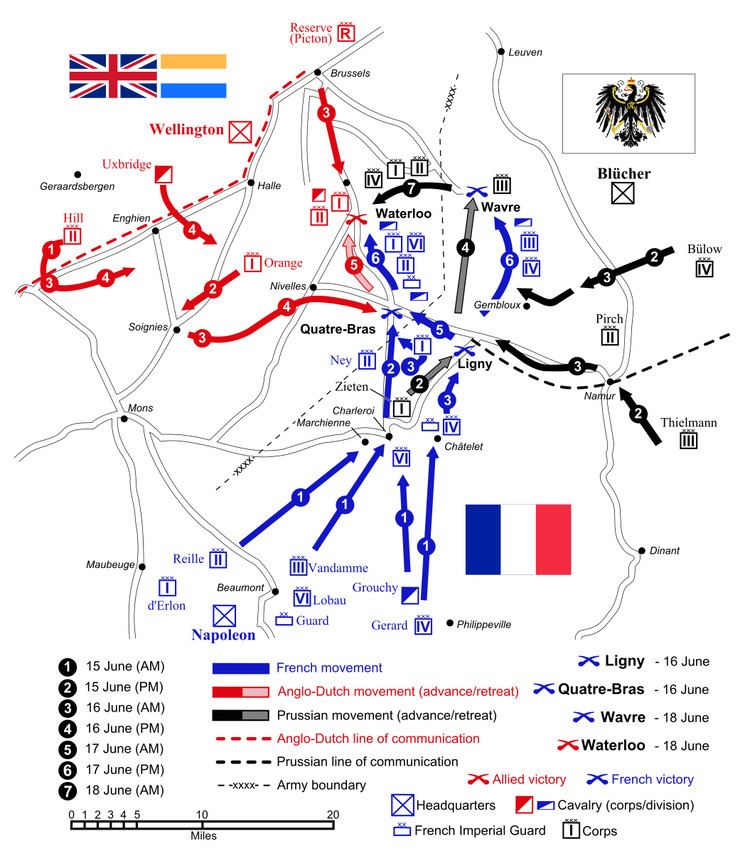 | ||
Similar Battle of Waterloo, Napoleonic Wars, Battle of Quatre Bras, Battle of Ligny, Hundred Days | ||
This is the complete order of battle for the four major battles of the Waterloo Campaign.
Contents
- Headquarters
- French Imperial Guard
- Anglo allied Army Order of Battle
- Headquarters and support regiments
- I Corps
- II Corps
- Reserves
- Prussian Army Order of Battle
- Staff
- References
Somebody needs to correct the French OOB for II Corps. According to Scott Bowden, just before the 1815 campaign, the 2nd Light was transferred from 5/II to 6/II with the 3rd Line going from 6/II to 5/II. A close reading of that researcher who personally visited the Armee du Nord records in France should suffice to make this change as well as the simple fact that said regiments fought the great battles from these formations.
Headquarters
L'Armée du Nord under the command of Emperor Napoleon I.
Major Général (Chief of Staff): Marshal Soult, Duke of Dalmatia.
Commander of artillery: General of Division Charles-Étienne-François Ruty.
Field commanders under the direct command of Emperor Napoleon:
French Imperial Guard
Anglo-allied Army Order of Battle
Combined British, Dutch and Hanoverian forces were under the supreme command of Field Marshal Arthur Wellesley, 1st Duke of Wellington. The Order of Battle included below reflects all units of the Anglo-allied Army including those that were not present for the battles themselves (units spread across the area or on garrison duty). The casualty numbers include all the casualties suffered by each regiment over the three days of fighting during the campaign from 16 June 1815 to dawn on 19 June 1815.
Present at the Battle of Waterloo Wellington had 71,257 soldiers available, 3,866 officers and 65,919 other ranks. By the end of the day's fighting the army had suffered 16,084 casualties (3,024 killed, 10,222 wounded and 2,838 missing) a loss of 24.6%.
Headquarters and support regiments
I Corps fielded 24,844 (1,233 officers and 23,383 other ranks) on 18 June 1815 taking into account those not present in the Order of Battle and the casualties on the previous two days.
I Corps
With so much of the Dutch Belgian contingent not present at the battle, only 579 officers and 8,677 men (9,256 in total) were fielded by II Corps.
II Corps
With only three regiments not present at the battle this Corps was the most complete at Waterloo fielding 16,133 (933 officers and 13,897 men) after taking into account the small losses at Quarte-Bras and during the retreat on 17 June 1815.
Reserves
The reserves, 34,394 men and 56 guns, came under the direct command of Wellington during the Battle of Waterloo. The British 7th Infantry Division under Major General Kenneth MacKenzie was not present at the battle as the brigade manned various garrisons around the area. The Hanoverian Reserve Division was also not present, again manning garrisons on behalf of the army. Actual combatants from the Reserve present at the battle numbered 18,964 with 56 guns.
Prussian Army Order of Battle
The Prussian Army was led by Field Marshal Gebhard Leberecht von Blücher, Prince of Wahlstadt and his chief of staff August von Gneisenau and remained independent from the allied Anglo-Dutch-German army during the course of the campaign.
Staff
Major General Karl von Grolman, was Quartermaster General.
